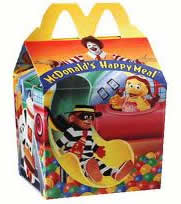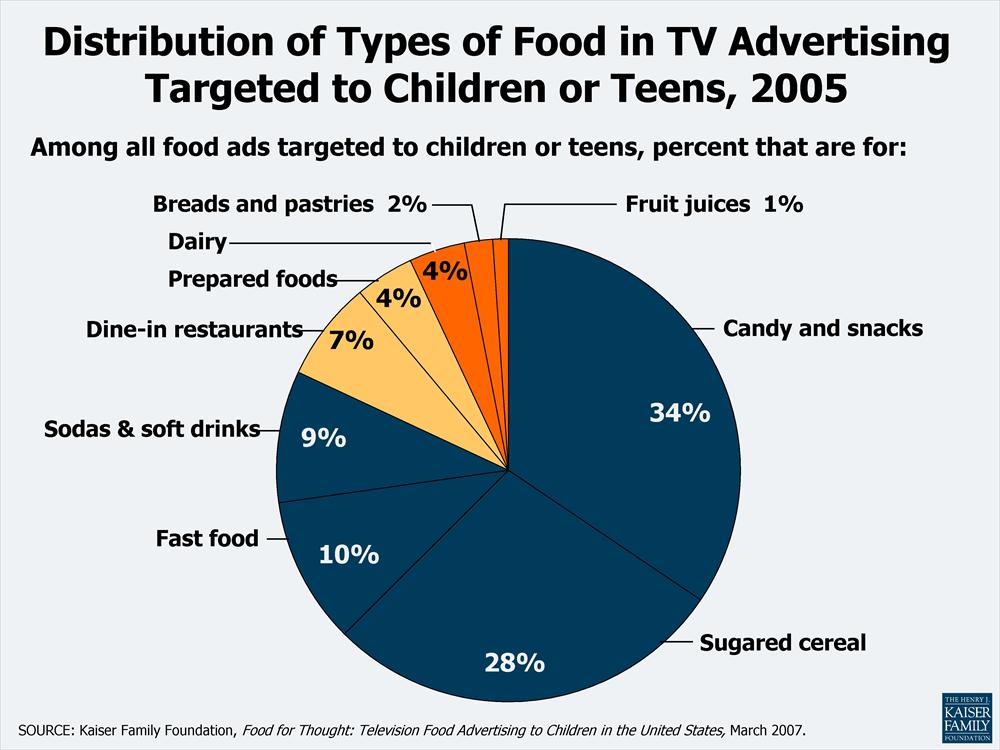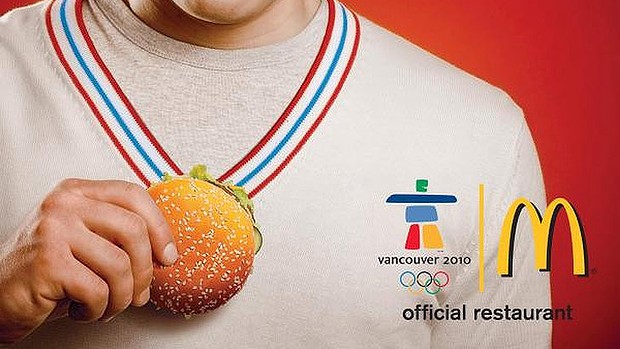Food companies exploit the inability of such young children to understand the purpose of the advertisements and the deception inherent in them. They seek to make food of little nutritional value seem to be exciting, delicious, and fun.
Free gifts are a particularly effective way of attracting child customers. Free toys can double or triple the sales of McDonald’s meals to children. One of the most successful was the Teenie Beanie Baby which was thought to have sold 100 million Happy Meals in ten days compared with normal sales of ten million per week.
 Fast food and cereal marketers often take advantage of children’s natural inclination to collect things by offering gifts in sets as collectors items. For example, when McDonalds gave toy Hummers with its happy meals as part of its “Hummer of a Summer promotion” there were 8 different Hummers to collect. When Frito-Lay offered small collector discs called Tazos free in its Doritos chip packets in 1996 it had to increase production by 40 per cent to keep up with demand.
Fast food and cereal marketers often take advantage of children’s natural inclination to collect things by offering gifts in sets as collectors items. For example, when McDonalds gave toy Hummers with its happy meals as part of its “Hummer of a Summer promotion” there were 8 different Hummers to collect. When Frito-Lay offered small collector discs called Tazos free in its Doritos chip packets in 1996 it had to increase production by 40 per cent to keep up with demand.
Food marketers targeting children seek to make their products fun, which means turning food into a form of entertainment or a play thing – this is referred to by the industry as ‘eatertainment’. For example Frito Lay seeks to present “food for the fun of it”. Woolworths produced sweets that flash when you press a button on the stick holding them. Food packaging is turned into something to play with or it may have games printed on it. Food can be shaped to be played with and toys produced in the shape of particular food brands.
Advertisers not only promote unhealthy foods but they create a culture where food is eaten for pleasure or fun without any need for discretion, limits or care. Often manufacturers use food additives such as colouring solely for the purpose of making it appealing and eye-catching to children. The UK Food Commission found that 75 per cent of food that contains high amounts of added fat, sugar and salt also contains ‘cosmetic additives’. These additives, including artificial colour, have been shown to increase hyperactivity in children.

Food marketing undermines the efforts of parents, teachers and doctors to teach children about healthy eating. The onslaught of advertisements for fast foods, sugary foods and salty foods encourage children to favour such foods over more healthy and natural alternatives, such as fruit and vegetables. The US Department of Agriculture claims that children get an appetite for high levels of sugar and salt in their food and drinks before they even go to school.

In the US:
In Australia:

The food and beverage industries have denied the link between their products and weight gain in children and funded several studies to support this denial. A Yale University survey of 88 studies found that “Studies funded by the food industry simply did not find the degree of negative health effects from soft drinks that independent scholars discovered.
Denial studies from the food industry include:
In 2002 a draft report of the Joint WHO/FAO Expert Consultation on Diet, Nutrition and the Prevention of Chronic Diseases called for stricter marketing rules and labelling, as well as taxes on sugar-rich food marketed to children. It prompted the American Advertising Federation, the American Association of Advertising Agencies, the Grocery Manufacturers of America, the National Soft Drink Association, the Snack Food Association, the National Confectioners Association, the US Chamber of Commerce and several other industry associations to write to the US secretary of Health and Human Services to “express our concerns” that the report would harm the US food industry. The industry letter argued the report “should be substantially modified before being issued by WHO and FAO”.
The following year the Sugar Association “threatened lobbying to block WHO funding if the report was not changed.” At the behest of industry lobbyists the Bush administration opposed WHO anti-obesity initiatives behind the scenes and objected to the way the WHO identified some foods as “bad”.
Manufacturers of junk food deny that there are good and bad foods, but instead insist that all foods have their place in a ‘balanced’ diet. They nevertheless seek to achieve maximum sales of their foods. For example, McDonald’s aims for 20 visits per month per customer. In its brochure Healthy Balance, it stresses the need for “a balanced diet and regular exercise” and implies that McDonald’s can contribute to that balance: “A typical McDonald’s meal of a Big Mac, French Fries and a Thick Shake contains foods from most of the core food groups, which are sources of riboflavin, calcium, phosphorus, thiamine, niacin, zinc, magnesium, iodine and iron…” They also add protein and vitamins to the list. However a person would need to walk for around 5.5 hours to burn off the calories of such a meal.
Coca Cola’s Beverage Institute for Health and Wellness emphasises the importance of drinking enough fluids so as not to become dehydrated and argues that any drink suits this purpose so “there’s no need to stick to plain water if it bores you”.
The food industry also argues that achieving a balanced diet is a parental responsibility and that government regulation of junk food advertising represents the intrusion of a “nanny state” into private lives. Advertisers nevertheless seek to market direct to children, bypassing parental gatekeepers where they can, encouraging pester power to overcome parental resistance. Moreover, the UK Office of Communications (Ofcom) found that mothers “are at a loss” as to how to make a healthy diet attractive to children in the face of the barrage of marketing making junk food attractive to them.
The food industry also thwarts the exercise of parental responsibility by lobbying against food labelling regulations and other sources of nutrition information being made available to parents. It has successfully lobbied for food disparagement laws in twelve US states making it difficult for critics to point out the shortcomings of their food. Jeff Richardson, director of the Centre for Health Economics at Monash University in Australia pointed out that “food marketing was so manipulative that a central free-market principal – that people would act in their own best interests – no longer applied in relation to food consumption.”
Junk food manufacturers blame lack of exercise, rather than junk food  marketing, for the rising tide of obesity and have recently been promoting exercise and associating themselves with exercise campaigns as part of their public relations efforts. Several beverage and fast food companies, such as McDonalds, have given out pedometers. Coke sponsors school playgrounds.
marketing, for the rising tide of obesity and have recently been promoting exercise and associating themselves with exercise campaigns as part of their public relations efforts. Several beverage and fast food companies, such as McDonalds, have given out pedometers. Coke sponsors school playgrounds.
Many junk food companies have sought to associate themselves with exercise and sport including Pepsi, Coca-Cola, Cadbury and Nestlé. However it is not realistic to believe that regular consumption of junk food can be counteracted with exercise as we saw with the example of the McDonalds meal.